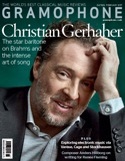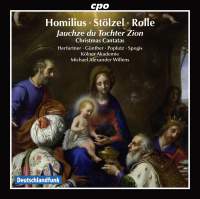Texte paru dans: / Appeared in: |
|
|
Outil de traduction (Très approximatif) |
|
|
Reviewer: Peter Quantrill One of many useful ways in which the late Peter Williams (the final version of whose monumentum pro JSB was reviewed by Lindsay Kemp in the December issue) cut his hero down to size was to place the bounds of historical context around the nature of Bach’s ‘originality’. Record companies have been slow to present the evidence on record but, as if to order, along comes an album presenting four of the composer’s contemporaries in impeccably stylish studio performances. Our understanding of the well-tilled field which Bach came to plough with such industry is most enhanced by two examples of the least familiar name on the bill, Johann Heinrich Rolle (1716‑85, plying his trade in Magdeburg). At first sight and hearing, the eschatological vision naturalistically unfurled to open Siehe, Finsternis bedecket das Erdenreich is hardly fit for the Christmas season unless it be to mark a year of disaster and catastrophe. However dramatic, the invernal storm blows itself out in the opening chorus, leaving the stage clear for soloists to rejoice in differing temperaments. The alto does so with a stately injunction to remember the poor accompanied by a positively Handelian walking bass and pair of obbligato horns. Rolle’s gift for a melting melody and sympathy for the alto voice is even more persuasively conveyed in the compassionate sweep of the aria that forms the counterbalance to general rejoicing in Jauchze, du Tochter Zion. Elsewhere there is much trumpet-anddrummery of larger energy than expressive force. It can be enjoyed rather than endured thanks to the warm sympathy that infuses both recording and performances with an appropriately festive spirit. Tempos are well judged by Michael Alexander Willens and not too hectic, the chorus is plausibly balanced with instrumental forces at two to a part and the organ and brass present a buttressing force of pleasingly architectural solidity. You would be hard pressed to guess from the tiny five movements of his six-minute cantata that Stölzel was also the mind behind the broad pathos of the aria formerly attributed to Bach as BWV53, Schlage doch, gewünschte Stunde. The contribution made by Homilius is as quirky as we have learnt to expect from the ongoing series on Carus, including a final chorale with a boldly open cadence. In Ehre sei Gott in der Höhe, Christoph Förster (1693-1745, in Merseburg, latterly itinerant) gives Hanna Herfurtner her chance to show off a secure coloratura technique with strings of pearly semiquavers; she and Carola Günther are the pick of a solid team of soloists. |
|




